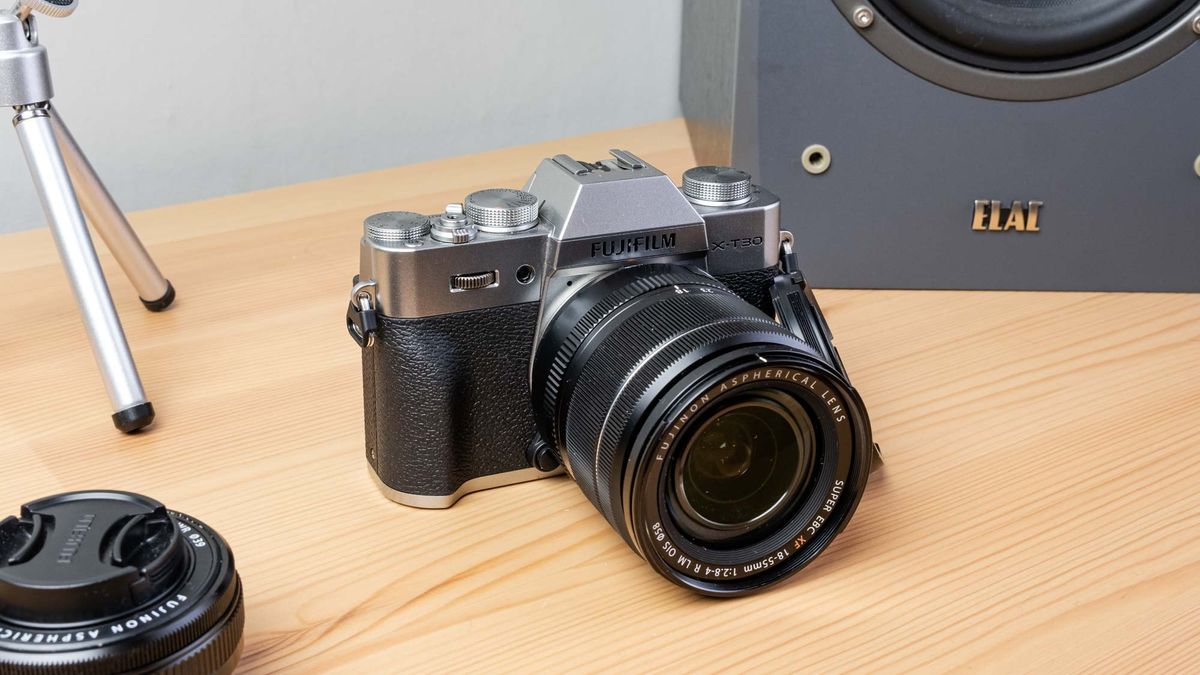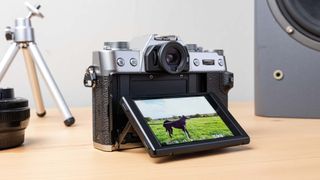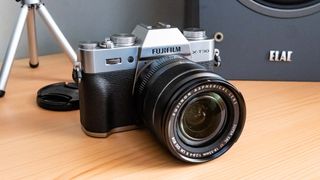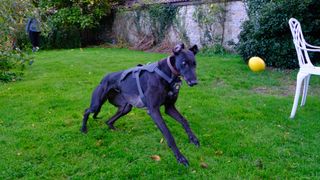Fujifilm X-T30 II review | Tom’s Guide
GoogleAds

Fujifilm X-T30 II: Specs
Sensor: 26.1MP APS-C X-Trans CMOS 4
Image processor: X-Processor 4
Image stabilization: No
AF points: 425-point
Viewfinder: 0.39-inch OLED EVF, 2.36 million dots
Display: 3.0-inch Tilt-Type colour LCD Touch Screen, 1.62 million dots
ISO: 160-12,800 (expandable to 80-51,200)
Max video resolution: 4K (6K oversampled) at 30p, 25p, 24p
Ports: USB Type-C, Micro HDMI, 2.5mm stereo, hot shoe, 1x UHS-1 SD/SDHC/SDXC
Wireless/Bluetooth: Yes
Shooting speed: 8fps mechanical, 30fps electronic
Battery life (CIPA): 390
Size/weight (body): 4.66 x 3.25 x 1.25 inches; 11.6 ounces
The Fujifilm X-T30 II is the successor to the Fujifilm X-T30, which we happily added to our list of the best cameras you can buy. It’s a relatively compact, mid-range mirrorless camera, aimed firmly at the enthusiast photographer market.
The Fujifilm X-T30 II builds on its predecessor, adding very little to what was already a decent product. Almost everything we loved has been carried over to the new model — namely, a great image sensor and autofocusing capabilities — but there aren’t really any improvements on the older model’s weaker points either.
Nevertheless, the Fujifilm X-T30 II, despite being only a modest upgrade, could still be the ideal choice for those wanting one of the best mirrorless cameras around, with fantastic image quality and a few professional features. Find out more in our full Fujifilm X-T30 II review.
Fujifilm X-T30 II review: Price and availability
The Fujifilm X-T30 II costs $899 / £799 in body-only configuration, $999 / £899 when bundled with the XC15-45mm F3.5-5.6 OIS PZ Lens, or $1,299 / £1,199 with the XF18-55mm F2.8-4 R LM OIS Lens.
I tested the camera using the XF18-55mm F2.8-4 lens, which makes a great pairing and is worth the extra spend. It offers a versatile zoom range of 27mm to 84mm full frame equivalent, making it a standard zoom — a category considered the workhorses of professional photographers. Optical quality was great and the lens also features optical image stabilization (OIS) to keep handheld shots blur free at slower shutter speeds. While the cheaper XC 15-45mm lens also offers OIS, its zoom range is smaller and its maximum aperture is narrower, so you may find yourself wanting some of the added features of the pricier kit lens before long anyway.
Fujifilm X-T30 II review: Design
The Fujifilm X-T30 II is beautiful, particularly in silver and black guise, and its premium, retro styling is what will draw many people to the camera and to Fujifilm in general. This isn’t superficial; the materials feel as high quality as they look. The camera’s brushed metal body is wrapped in grippy plastic — both look and feel sturdy. Dials and levers have a satisfying clunk to them, the side port snaps open with a powerful spring, and buttons travel nicely, with the plastic ones feeding back via weighty clicks.

(Image credit: Tom’s Guide)
The X-T30 II is compact and extremely light, making the camera feel a little unsubstantial to anyone used to professional bodies. It feels far from cheap, though, thanks to the high quality build materials, and its diminutive weight and profile offer serious handling benefits. I took the camera on a series of long walks using a wrist strap, where large, weightier cameras can get particularly annoying. The X-T30 II caused no issues all day. Thanks additionally to a small ergo grip and tilting screen, the compact form also makes the camera easy to use at odd and low angles.

(Image credit: Tom’s Guide)
The EVF and LCD touch screen are both reasonably bright and good enough for most day to day usage. The LCD screen isn’t particularly sharp, despite being upgraded from the 1.04M dots of its predecessor to 1.62M dots. However, I didn’t find this a problem, as I only really use rear screens for having quick looks at images anyway, and used the 2.36M dot EVF for detailed focus checking.

(Image credit: Tom’s Guide)
The Fujifilm X-T30 II only features a single UHS-1 SD card slot, but that’s not unexpected at this price. It does feature a respectable range of I/O however, given its small size. There’s a 2.5mm audio jack, a mini-HDMI as well as a USB-C, meaning videographers could hook up a range of peripherals if needed.
Fujifilm X-T30 II review: Controls
The Fujifilm X-T30 II squeezes a decent number of controls into its compact body. There are the classic dials for shutter speed and exposure compensation, a front focus mode switch, and a frontal dial mappable to ISO, shutter or aperture. I’ve never been a fan of the front dial. I find it temperamental and often accidentally push it and change function, which is frustrating during fast-paced usage.
Speaking of knocking controls, by far the most infuriating aspect of the X-T30 II — and something which has unfortunately been carried over from its predecessor — is the Q button. The button is placed on top of the rear thumb rest and gets knocked constantly, which led to many missed shots during my testing.

(Image credit: Tom’s Guide)
There’s also the touch screen, which essentially adds an extra four function controls to the scant customizable function buttons on the camera itself. This gives you a good amount of remappable gestures and buttons in total, but again I found myself knocking the screen and changing things. These control issues seem to be the result of Fuji’s current compact camera design language conflicting with clumsy or larger hands like mine, as I also experience such problems with the identical front dial and touch screen gestures on the X-E4.

(Image credit: Tom’s Guide)
The X-T30 II’s menu system may seem a little convoluted and tricky to navigate if you’re a newcomer to the brand. As with any other complicated menu system, though, you eventually get used to it with a bit of time, and I found I could map most regularly required functions to buttons or gestures, removing the need to scour menus.
Fujifilm X-T30 II review: Performance
The Fujifilm X-T30 II features a 425-point hybrid phase detection autofocus system, the same as found in the original X-T30, albeit with improved algorithms and low-light performance. It’s reliable-enough for most slower-paced and casual situations, but struggles with fast moving subjects and in low light.
Fujfilm claims the X-T30 II can autofocus down to EV -7, so I first tested the camera in a dim room lit by two small lamps — a moderately challenging lighting setup. The X-T30 II wasn’t terrible, but searched quite a bit and sometimes failed to lock onto anything. Performance wasn’t bad, but was a little disappointing.

(Image credit: Tom’s Guide)
To test the eye and face detection and single-shot focusing speeds, I took some quickfire images of my family around a table, adjusting position and pressing the shutter rapidly each time. Each time, the X-T30 II performed well, accurately detecting and locking onto eyes and faces. It even managed to lock into the eye and face of the Buddha statue I keep in my office. The AF detection doesn’t extend to animals, though, which may be an issue for casual photographers with pets. Getting a few photos of my two dogs for an upcoming calendar proved tricky, but usable images were manageable (by using lots of treats as bribery for staying still.)
To try out the continuous autofocus and tracking capabilities, I again used my dogs, who are both ex-racing greyhounds. Lighting conditions were tricky, with failing daylight and fast shutter speeds required. Even still, the X-T30 II performed much more poorly than I’d have liked. I set the camera to continuous AF and the X-T30 II failed to keep up with the dogs running at around half pelt (about 20mph), so I came away with very few usable photos after firing off numerous high speed bursts. As you can see in the image below, despite focusing on Nutty just before she started running, the X-T30 II failed to keep her in focus throughout the frame, instead focusing on the background. Fast moving subjects are not this camera’s forté.

(Image credit: Tom’s Guide)
I did, however, find the continuous autofocus very good when it came to shooting some basic video in my office. The autofocus pulled quickly and accurately as I switched between subjects, with very little searching.
In terms of its shooting rate, the Fujifilm X-T30 II boasts an impressive 30fps max using e-shutter, albeit with a 1.25x crop, while mechanical shutter manages 8fps. I shot in RAW and JPEG using a UHS-1, UHS Speed 3 card, and the buffer filled pretty quickly, leaving me stuck waiting for the camera to slowly load images to the card. Again, then, high speed isn’t where this camera shines, but that isn’t bad performance given this is a mid-range camera.
Like its predecessor, the Fujifilm X-T30 II lacks IBIS, but I didn’t find this an issue during some vacation, portraiture and landscape shooting where longer exposures handheld aren’t frequently needed. What’s more, many of Fuji’s lenses, including the one tested, feature optical stabilization. If you plan on using third party lenses, are going to be shooting video or plan on doing a lot of low light photography, you may wish to look elsewhere for a body with IBIS.
While not impressive, battery life is still respectable, with a 390 shot CIPA rating. I used the camera casually throughout the day and was left with a single bar left in the evening. However, I doubt the battery would’ve lasted all day under more intensive usage.
Fujifilm X-T30 II review: Image quality
The Fujifilm X-T30 II excels in its image quality, which is superb, as with other models using the 26.1MP X-Trans CMOS 4 sensor and X-Processor 4. Auto white balance performs well and images are crisp and sharp, even when cropped, with plenty of detail visible. Cropping into the image of the house below, you can still make out the details in the brick work, as well as the individual diamond-shaped glass panes in the windows. The image below uses the Velvia Vivid film simulation profile and, while indeed vivid, colors are still accurate and natural. The grass, sky and sandstone, for example, all look true to how they looked on the sunny day, without seeming unpleasant or overly saturated.

(Image credit: Tom’s Guide)
The camera manages dynamic range very well. I tested the Fujifilm X-T30 II on a bright sunny day in the gardens of a stately home in Somerset, UK, with high walls, plenty of trees and enormous shaped hedges to create lots of shade and present challenging dynamic range conditions. Just for good measure, I also took some shots with DR adjustments off to see how the sensor did without it. As you can see from the image below, on Auto ISO and Auto WB, with DR adjustments off, the results were excellent, with very few blown out highlights and deep shadows.

(Image credit: Tom’s Guide)
The X-Trans CMOS 4 sensor is backlit to minimize noise, and it does a decent job. In the image below, you can see the difference between a shot at ISO 160 and a shot at ISO 12,800. The ISO 12,800 features noticeable noise, especially on the grey wall in the background, but it certainly isn’t ruinous, and could be mostly smoothed out using noise reduction in post. Going up past this to the expandable maximum of ISO 51,200 will obviously result in more noise and may affect the usability of images. Realistically, though, even ISO 12,800 is higher than many photographers are willing to push sensitivity in most situations, so it’s good to see the camera performing well there.
One of Fujifilm’s USPs today is its film simulation color profiles, and oh boy are they beautiful. The X-T30 II comes loaded with 18 color profiles (two more than the X-T30) mimicking classic Fuji film stock, plus some creative filters such as a toy camera mode. The latter are fun, but it’s the film sim profiles that provide the bulk of creative options for photographers and videographers. Thanks to these color profiles, in conjunction with the camera’s capable light metering in auto ISO mode and solid image quality, I had usable, beautiful photos straight out of the camera with no need for editing. This will be a boon to anyone looking to shoot photos, but also video, as you could feasibly cut out long periods spent color grading but still deliver beautiful content by shooting in these profiles.

(Image credit: Tom’s Guide)
The image above was taken using one of the Acros black and white profiles — my favorites — which give a vintage and artistic feel.
Fujifilm X-T30 II review: Video
The Fujifilm X-T30 II is, as per Fuji’s marketing material, primarily aimed at enthusiast photographers. As such, I geared the bulk of my testing towards photography. There are a few impressive specs that allow the X-T30 II to hold its own in terms of shooting clips, or to make it a good camera for photographers looking to dip their toe in videography, but it certainly isn’t a camera for serious video content creation.
As mentioned above, the X-T30 II’s autofocus pulls quickly and reliably when shooting video and there are a good number of ports for hooking up peripherals. There are the aforementioned creative film simulation profiles for pretty footage straight from camera, although the X-T30 II supports F-Log for more flexibility in post, and can also output an F-Log View Assist to an LCD monitor, to give you an accurate idea during shooting of what footage will look like when you get it into post production.
The X-T30 II shoots 4K video with a 30-minute limit, which is 20 minutes longer than the original X-T30. 4K video is oversampled from 6K for added sharpness and reduced noise over standard 4K, but 4K is only possible up to 30p.
The Fujifilm X-T30 II also shoots 240fps in Full HD, while its predecessor only shot 120fps. That means you can get slower footage with the X-T30 II than with the X-T30 and many other cameras in the mid-range and even high-end. You can only shoot at 240fps for 3 minutes, but that should be long enough for some beautiful slow motion b-roll.
If you want to put some focus into video, either now or in the future, consider the Fujifilm X-S10 ($899 / £949) which features IBIS, but lacks the retro styling of the X-T30 II. If your budget can stretch a little further, we’d recommend the Sony Alpha a6600 thanks to its IBIS, range of log profiles and HDR output, plus Sony’s legendary AF. Despite being a couple of years old, we still rate the a6600 as the best mirrorless camera for video.
Fujifilm X-T30 II review: Verdict
The Fujifilm X-T30 II isn’t much different from its predecessor, so if you’re thinking of upgrading from the original X-T30 to the X-T30 II, we wouldn’t recommend you do so. The X-T30 II’s improved LCD screen won’t make a huge difference day to day. Its two extra film simulation profiles are nice to have, but not worth upgrading for. And the increased video credentials — longer 4K recording and Full HD 240fps — don’t make it a markedly better videography proposition either, at least not to anyone considering hardcore video creation.
However, the X-T30 isn’t a bad camera at all, and therefore neither is the X-T30 II, thanks to the same sensor, the same AF system (albeit with a few tweaks), plus the same fantastic design, handling and build quality. Aside from the awful Q button placement, the X-T30 II is simply carrying on a winning stills formula, and is now the only of the two cameras that you’ll find new. So, if you’re new to the line, want beautiful stills, aren’t dead set on IBIS and won’t be taking video too seriously, the X-T30 II is a great package at a fair price.
Source : https://www.tomsguide.com/reviews/fujifilm-x-t30-ii
Author :
Date : 2023-01-26 08:00:00
GoogleAds




